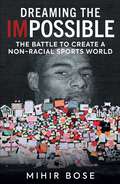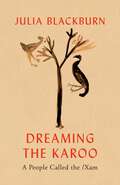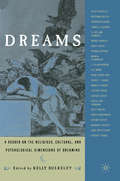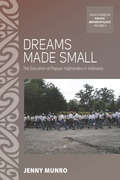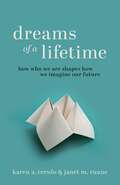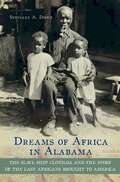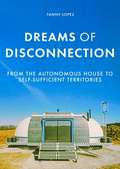- Table View
- List View
Dreaming and Historical Consciousness in Island Greece (Early Modern And Greek Studies)
by Charles StewartOn publication in 2012, Dreaming and Historical Consciousness in Island Greece quickly met wide acclaim as a gripping work that, according to the Times Literary Supplement, “offers a wholly new way of thinking about dreams in their social contexts.” It tells an extraordinary story of spiritual fervor, prophecy, and the ghosts of the distant past coming alive in the present. This new affordable paperback brings it to the wider audience that it deserves. Charles Stewart tells the story of the inhabitants of Kóronos, on the Greek island of Naxos, who, in the 1830s, began experiencing dreams in which the Virgin Mary instructed them to search for buried Christian icons nearby and build a church to house the ones they found. Miraculously, they dug and found several icons and human remains, and at night the ancient owners of them would speak to them in dreams. The inhabitants built the church and in the years since have experienced further waves of dreams and startling prophesies that shaped their understanding of the past and future and often put them at odds with state authorities. Today, Kóronos is the site of one of the largest annual pilgrimages in the Mediterranean. Telling this fascinating story, Stewart draws on his long-term fieldwork and original historical sources to explore dreaming as a mediator of historical change, while widening the understanding of historical consciousness and history itself.
Dreaming and Historical Consciousness in Island Greece (Early Modern And Greek Studies #4)
by Charles StewartOn publication in 2012, Dreaming and Historical Consciousness in Island Greece quickly met wide acclaim as a gripping work that, according to the Times Literary Supplement, “offers a wholly new way of thinking about dreams in their social contexts.” It tells an extraordinary story of spiritual fervor, prophecy, and the ghosts of the distant past coming alive in the present. This new affordable paperback brings it to the wider audience that it deserves. Charles Stewart tells the story of the inhabitants of Kóronos, on the Greek island of Naxos, who, in the 1830s, began experiencing dreams in which the Virgin Mary instructed them to search for buried Christian icons nearby and build a church to house the ones they found. Miraculously, they dug and found several icons and human remains, and at night the ancient owners of them would speak to them in dreams. The inhabitants built the church and in the years since have experienced further waves of dreams and startling prophesies that shaped their understanding of the past and future and often put them at odds with state authorities. Today, Kóronos is the site of one of the largest annual pilgrimages in the Mediterranean. Telling this fascinating story, Stewart draws on his long-term fieldwork and original historical sources to explore dreaming as a mediator of historical change, while widening the understanding of historical consciousness and history itself.
Dreaming Big in Post-War Greece: Neighborhood, Life Style, and Everyday Practices in the City of Thessaloniki (Kultur und soziale Praxis)
by Miltiadis ZermpoulisIn post-war Greece, Western Allies, the country's conservative political elite and parts of the middle class share a dream of consolidating and maintaining the country's Western, bourgeois-liberal orientation. In 1947, with the civil war still raging in the country, the Greek government chooses the path of the capitalist countries and joins the American program for the reconstruction of war-torn Europe. Miltiadis Zermpoulis focuses on the impact and significance of the social and political changes brought about by the civil war, the dominance of conservatives in the political arena and the promotion of political surveillance and compliance technologies in the daily life of Greece's second largest city, Thessaloniki.
Dreaming Culture: Meanings, Models, and Power in U.S. American Dreams (Culture, Mind, and Society)
by J. MageoDreams seem the most private territory of experience. Yet Dreaming Culture argues they are a space in which we practice, consider, question, and adapt cultural models of the self, gender, sexuality, relationships, and agency. Through an innovative "dream ethnography" from college students in the northwestern U.S., this book contributes to recent research on dreaming and the brain in psychology and continuing research on dreaming and the self in clinical psychology and psychological anthropology. Dreaming Culture uses critical theory to understand power relations embedded in cultural models, a perspective often lacking in cognitive anthropology and in psychological studies of self and mind.
Dreaming Global Change, Doing Local Feminisms: Visions of Feminism. Global North/Global South Encounters, Conversations and Disagreements
by Lena Martinsson Diana MulinariIn a world where frontiers are militarised and classifications systems defining rights and belonging are reinforced, transnational feminist agendas are fundamental. We use the concept of ‘scholarships of hope’ to analyse the diversity of feminist struggles and imaginaries in diverse geopolitical locations. Dreaming Global Change, Doing Local Feminisms explores subversive practices of knowledge production that challenge Eurocentric scientific models and agendas. The book also explores the tensions and challenges of doing transnational feminist theory at the crossroads between feminist scholarship and feminist activism. In conjunction, these chapters provide a solid analysis framed by feminist methodologies opening complexities and contradictions of individual and collective feminist and trans identity struggles in Argentina, Belarus, Pakistan, Sweden, Taiwan and Turkey. These identities and struggles are rooted in transnational and local genealogies that go beyond the narratives of the West as the origin for democracy and human rights, providing powerful agendas for alternative futures.
Dreaming Global Change, Doing Local Feminisms: Visions of Feminism. Global North/Global South Encounters, Conversations and Disagreements
by Lena Martinsson Diana MulinariIn a world where frontiers are militarised and classifications systems defining rights and belonging are reinforced, transnational feminist agendas are fundamental. We use the concept of ‘scholarships of hope’ to analyse the diversity of feminist struggles and imaginaries in diverse geopolitical locations. Dreaming Global Change, Doing Local Feminisms explores subversive practices of knowledge production that challenge Eurocentric scientific models and agendas. The book also explores the tensions and challenges of doing transnational feminist theory at the crossroads between feminist scholarship and feminist activism. In conjunction, these chapters provide a solid analysis framed by feminist methodologies opening complexities and contradictions of individual and collective feminist and trans identity struggles in Argentina, Belarus, Pakistan, Sweden, Taiwan and Turkey. These identities and struggles are rooted in transnational and local genealogies that go beyond the narratives of the West as the origin for democracy and human rights, providing powerful agendas for alternative futures.
Dreaming the English Renaissance: Politics and Desire in Court and Culture
by C. LevinDreaming the English Renaissance examines ideas about dreams, actual dreams people had and recorded, and the many ways dreams were used in the culture and politics of the Tutor/Stuart age in order to provide a window into the mental life and the most profound beliefs of people of the time.
Dreaming the Impossible: The Battle to Create a Non-Racial Sports World
by Mihir BoseThe British, who are rightly proud of their sporting traditions, are now having to come to terms with the dark, unacknowledged, past of racism in sport – until now the truth that dare not speak its name.Conscious and unconscious racism have for decades blighted the lives of talented black and Asian sportsmen and women, preventing them from fulfilling their potential. In Formula One, despite Lewis Hamilton’s stellar achievements, barely one per cent of the 40,000 people employed in the sport are of ethnic minority heritage. In football, Britain’s premier sport, the number of non-white managers in the professional game remains pitifully small. And in cricket, Azeem Rafiq’s testimony to the Commons select committee has exposed the scandal of prejudice faced by Asian cricketers in the game.Veteran author and journalist Mihir Bose examines the way racism has affected black and Asian sportsmen and women and how attitudes have evolved over the past fifty years. He looks in depth at the controversies that have beset sport at all levels: from grassroots to international competitions and how the ‘Black Lives Matter’ movement has had a seismic impact throughout sport, with black sports personalities leading the fight against racism. However, this has also led to a worrying white fatigue.Talking to people from playing field to boardroom and the media world, he illustrates the complexities and striking contrasts in attitudes towards race. We hear the voices of players, coaches and administrators as Mihir Bose explores the question of how the dream of a truly non-racial sports world can become a reality.
Dreaming the Karoo: A People Called the /Xam
by Julia BlackburnA spellbinding new book by the much-acclaimed writer, a journey to South Africa in search of the lost people called the /Xam - a haunting book about the brutality of colonial frontiers and the fate of those they dispossess.In spring 2020, Julia Blackburn travelled to the Karoo region of South Africa to see for herself the ancestral lands that had once belonged to an indigenous group called the /Xam.Throughout the nineteenth century the /Xam were persecuted and denied the right to live in their own territories. In the 1870s, facing cultural extinction, several /Xam individuals agreed to teach their intricate language to a German philologist and his indomitable English sister-in-law. The result was the Bleek-Lloyd Archive: 60,000 notebook pages in which their dreams, memories and beliefs, alongside the traumas of their more recent history, were meticulously recorded word for word. It is an extraordinary document which gives voice to a way of living in the world which we have all but lost. 'All things were once people', the /Xam said.Blackburn's journey to the Karoo was cut short by the outbreak of the global pandemic, but she had gathered enough from reading the archive, seeing the /Xam lands and from talking to anyone and everyone she met along the way, to be able to write this haunting and powerful book, while living her own precarious lockdown life. Dreaming the Karoo is a spellbinding new masterpiece by one of our greatest and most original non-fiction writers.
Dreaming To Some Purpose: The Autobiography Of Colin Wilson
by Colin WilsonColin Wilson is the bete-noir of the Oxbridge literary establishment. He never went to university, let alone Oxbridge, yet wrote The Outsider, a brilliant account of the pain of being alive today, when he was just twenty-four. It sold millions of copies around the world, and he was acclaimed as one of the leading intellectuals of the age, finding a huge audience with the anti-establishment, alternative and underground thinkers. Because of his radically new attitudes he was - with John Osborne - dubbed an 'angry young man' in the article that originally coined that phrase. In this way a young man from a working class background suddenly found himself moving in the most colourful literary and artistic circles of the day. In his autobiography he tells stories about, among others, Aldous Huxley, Angus Wilson, John Osborne, Kingsley Amis, Kenneth Tynan, Francis Bacon and Norman Mailer - all observed with a true outsider's eye for absurdity. He is regarded by many as a true literary hero - Julian Cope stopped a recent concert to pay tribute to Wilson who as sitting in the audience and Donovan Leitch dedicates his new autobiography to him - but he also has huge mass market appeal. His insightful, brilliant books on the Occult, the Mysteries and Atlantis and the Sphinx were all huge bestsellers netting millions of copies. In this return to the themes of The Outsider, looked at from the point of his own life story, he again proves himself one of the great intellectuals of our age, never ceasing to wrestle with the great questions of life and death, and writing with an erudition and an easy way with ideas that is rare in English literary life.
Dreamland: The True Tale of America's Opiate Epidemic
by Sam QuinonesWinner of the NBCC Award for General NonfictionNamed on Amazon's Best Books of the Year 2015--Michael Botticelli, U.S. Drug Czar (Politico) Favorite Book of the Year--Angus Deaton, Nobel Prize Economics (Bloomberg/WSJ) Best Books of 2015--Matt Bevin, Governor of Kentucky (WSJ) Books of the Year--Slate.com's 10 Best Books of 2015--Entertainment Weekly's 10 Best Books of 2015 --Buzzfeed's 19 Best Nonfiction Books of 2015--The Daily Beast's Best Big Idea Books of 2015--Seattle Times' Best Books of 2015--Boston Globe's Best Books of 2015--St. Louis Post-Dispatch's Best Books of 2015--The Guardian's The Best Book We Read All Year--Audible's Best Books of 2015--Texas Observer's Five Books We Loved in 2015--Chicago Public Library's Best Nonfiction Books of 2015From a small town in Mexico to the boardrooms of Big Pharma to main streets nationwide, an explosive and shocking account of addiction in the heartland of America.In 1929, in the blue-collar city of Portsmouth, Ohio, a company built a swimming pool the size of a football field; named Dreamland, it became the vital center of the community. Now, addiction has devastated Portsmouth, as it has hundreds of small rural towns and suburbs across America--addiction like no other the country has ever faced. How that happened is the riveting story of Dreamland. With a great reporter's narrative skill and the storytelling ability of a novelist, acclaimed journalist Sam Quinones weaves together two classic tales of capitalism run amok whose unintentional collision has been catastrophic. The unfettered prescribing of pain medications during the 1990s reached its peak in Purdue Pharma's campaign to market OxyContin, its new, expensive--extremely addictive--miracle painkiller. Meanwhile, a massive influx of black tar heroin--cheap, potent, and originating from one small county on Mexico's west coast, independent of any drug cartel--assaulted small town and mid-sized cities across the country, driven by a brilliant, almost unbeatable marketing and distribution system. Together these phenomena continue to lay waste to communities from Tennessee to Oregon, Indiana to New Mexico. Introducing a memorable cast of characters--pharma pioneers, young Mexican entrepreneurs, narcotics investigators, survivors, and parents--Quinones shows how these tales fit together. Dreamland is a revelatory account of the corrosive threat facing America and its heartland.
Dreams: A Reader on Religious, Cultural and Psychological Dimensions of Dreaming
by K. BulkeleyThe recent centennial of the original publication of Sigmund Freud's The Interpretation of Dreams has generated a new wave of critical reappraisals of this monumental work. Considered one of the most important books in Western history, scholars from an astonishing variety of academic fields continue to wrestle with Freud's intricate theories and insights. Dreams is a long overdue collection of writing on dreams from many of the top scholars in religious studies, anthropology, and psychology departments. The volume is organized into three thematic sections: traditions, individuals and methods. The twenty-three articles highlight the most important theories, the most contentious debates, and the most far-reaching implications of this growing field of study.
Dreams and Modernity: A Cultural History (Directions in Cultural History)
by Natalya Lusty Helen GrothDreams and Modernity: A Cultural History explores the dream as a distinctively modern object of inquiry and as a fundamental aspect of identity and culture in the nineteenth and early twentieth century. While dreams have been a sustained object of fascination from the ancient world to the present, what sets this period apart is the unprecedented interest in dream writing and interpretation in the psychological sciences, and the migration of these ideas into a wide range of cultural disciplines and practices. Authors Helen Groth and Natalya Lusty examine how the intensification and cross-fertilization of ideas about dreams in this period became a catalyst for new kinds of networks of knowledge across aesthetic, psychological, philosophical and vernacular domains. In uncovering a complex and diverse archive, Dreams and Modernity reveals how the explosion of interest in dreams informed the psychic, imaginative and intimate life of the modern subject. Individual chapters in the book explore popular traditions of dream interpretation in the 19th century; the archival impetus of dream research in this period, including the Society for Psychical Research and the Mass Observation movement; and the reception and extension of Freud’s dream book in Britain in the early decades of the twentieth century. This engaging interdisciplinary book will appeal to both scholars and upper level students of cultural studies, cultural history, Victorian studies, literary studies, gender studies and modernist studies.
Dreams and Modernity: A Cultural History (Directions in Cultural History)
by Natalya Lusty Helen GrothDreams and Modernity: A Cultural History explores the dream as a distinctively modern object of inquiry and as a fundamental aspect of identity and culture in the nineteenth and early twentieth century. While dreams have been a sustained object of fascination from the ancient world to the present, what sets this period apart is the unprecedented interest in dream writing and interpretation in the psychological sciences, and the migration of these ideas into a wide range of cultural disciplines and practices. Authors Helen Groth and Natalya Lusty examine how the intensification and cross-fertilization of ideas about dreams in this period became a catalyst for new kinds of networks of knowledge across aesthetic, psychological, philosophical and vernacular domains. In uncovering a complex and diverse archive, Dreams and Modernity reveals how the explosion of interest in dreams informed the psychic, imaginative and intimate life of the modern subject. Individual chapters in the book explore popular traditions of dream interpretation in the 19th century; the archival impetus of dream research in this period, including the Society for Psychical Research and the Mass Observation movement; and the reception and extension of Freud’s dream book in Britain in the early decades of the twentieth century. This engaging interdisciplinary book will appeal to both scholars and upper level students of cultural studies, cultural history, Victorian studies, literary studies, gender studies and modernist studies.
Dreams for Dead Bodies: Blackness, Labor, and the Corpus of American Detective Fiction (Class : Culture)
by M. Michelle RobinsonDreams for Dead Bodies: Blackness, Labor, and the Corpus of American Detective Fiction offers new arguments about the origins of detective fiction in the United States, tracing the lineage of the genre back to unexpected texts and uncovering how authors such as Edgar Allan Poe, Mark Twain, Pauline Hopkins, and Rudolph Fisher made use of the genre’s puzzle-elements to explore the shifting dynamics of race and labor in America. The author constructs an interracial genealogy of detective fiction to create a nuanced picture of the ways that black and white authors appropriated and cultivated literary conventions that coalesced in a recognizable genre at the turn of the twentieth century. These authors tinkered with detective fiction’s puzzle-elements to address a variety of historical contexts, including the exigencies of chattel slavery, the erosion of working-class solidarities by racial and ethnic competition, and accelerated mass production. Dreams for Dead Bodies demonstrates that nineteenth- and early twentieth-century American literature was broadly engaged with detective fiction, and that authors rehearsed and refined its formal elements in literary works typically relegated to the margins of the genre. By looking at these margins, the book argues, we can better understand the origins and cultural functions of American detective fiction.
Dreams in American Television Narratives: From Dallas to Buffy
by Cynthia BurkheadDreams in Television Narratives is the first comprehensive analysis of one of American television's most frequently utilized tropes, the dream. From its beginning, television has been a storytelling medium. Whether delivered to a live audience or played out on a sound stage, narratives and those who write them have always been the crux of the television program. While film can claim a long history of scholarly inquiry into the connection between film and dreams, no comprehensive research exists on the subject of television dreams. Locating its primary function as narrative, the author uses examples from American sitcoms and dramatic programs, analyzing the narrative functions of dreams using, as its frame, Carl Jung's narrative stages of the dream: exposition, development, culmination, and conclusion. While television dreams are analyzed throughout, case studies of the television programs The Sopranos and Buffy the Vampire Slayer are included to show in detail how dreams function throughout a television series. Includes a compendium of over 1000 television episodes that include dreams, a valuable tool for any television scholar or enthusiast.
Dreams in American Television Narratives: From Dallas to Buffy
by Cynthia BurkheadDreams in Television Narratives is the first comprehensive analysis of one of American television's most frequently utilized tropes, the dream. From its beginning, television has been a storytelling medium. Whether delivered to a live audience or played out on a sound stage, narratives and those who write them have always been the crux of the television program. While film can claim a long history of scholarly inquiry into the connection between film and dreams, no comprehensive research exists on the subject of television dreams. Locating its primary function as narrative, the author uses examples from American sitcoms and dramatic programs, analyzing the narrative functions of dreams using, as its frame, Carl Jung's narrative stages of the dream: exposition, development, culmination, and conclusion. While television dreams are analyzed throughout, case studies of the television programs The Sopranos and Buffy the Vampire Slayer are included to show in detail how dreams function throughout a television series. Includes a compendium of over 1000 television episodes that include dreams, a valuable tool for any television scholar or enthusiast.
Dreams in Chinese Fiction: Spiritism, Aestheticism, and Nationalism (Routledge Focus on Literature)
by Johannes D. KaminskiThis book considers the contemporary political formula of the “Chinese Dream” in the light of the treatment of dreams in Chinese literary history since antiquity. Sinic literary and philosophical texts document an extensive spectrum of dream possibilities: starting with Zhuangzi’s eminent butterfly dream, an early example of the inversion of the dreamer’s reality, through to confusing visions of the spiritual realm. In classical dramas, novels, and ghost stories, dreams see the earthly realm enter into conflict with higher realms of existence. They indulge the dreamer’s quest for sensual pleasures, but then spiritual beings relentlessly harvest the dreamers’ life energy. Dreams promise spiritual enlightenment – only to abandon the dreamer in a state of utter confusion. In the early twentieth century, traditional dream knowledge is abandoned in favour or Freudian episodes of sexual repression. In this context, the collective national dream emerges as an unexpected vehicle of the pained individual’s hope for national rejuvenation.
Dreams in Chinese Fiction: Spiritism, Aestheticism, and Nationalism (Routledge Focus on Literature)
by Johannes D. KaminskiThis book considers the contemporary political formula of the “Chinese Dream” in the light of the treatment of dreams in Chinese literary history since antiquity. Sinic literary and philosophical texts document an extensive spectrum of dream possibilities: starting with Zhuangzi’s eminent butterfly dream, an early example of the inversion of the dreamer’s reality, through to confusing visions of the spiritual realm. In classical dramas, novels, and ghost stories, dreams see the earthly realm enter into conflict with higher realms of existence. They indulge the dreamer’s quest for sensual pleasures, but then spiritual beings relentlessly harvest the dreamers’ life energy. Dreams promise spiritual enlightenment – only to abandon the dreamer in a state of utter confusion. In the early twentieth century, traditional dream knowledge is abandoned in favour or Freudian episodes of sexual repression. In this context, the collective national dream emerges as an unexpected vehicle of the pained individual’s hope for national rejuvenation.
Dreams Made Small: The Education of Papuan Highlanders in Indonesia (ASAO Studies in Pacific Anthropology #9)
by Jenny MunroFor the last five decades, the Dani of the central highlands of West Papua, along with other Papuans, have struggled with the oppressive conditions of Indonesian rule. Formal education holds the promise of escape from stigmatization and violence. Dreams Made Small offers an in-depth, ethnographic look at journeys of education among young Dani men and women, asking us to think differently about education as a trajectory for transformation and belonging, and ultimately revealing how dreams of equality are shaped and reshaped in the face of multiple constraints.
Dreams of a Lifetime: How Who We Are Shapes How We Imagine Our Future
by Karen A. Cerulo Janet M. RuaneHow social status shapes our dreams of the future and inhibits the lives we envision for ourselvesMost of us understand that a person’s place in society can close doors to opportunity, but anything is possible when we dream about what might be, or so we think. Dreams of a Lifetime reveals that what and how we dream—and whether we believe our dreams can actually come true—are tied to our social class, gender, race, age, and life events.Karen Cerulo and Janet Ruane argue that our social location shapes the seemingly private and unique life of our minds. We are all free to dream about possibilities, but not all dreamers are equal. Cerulo and Ruane show how our social position ingrains itself on our mind’s eye, quietly influencing the nature of our dreams, whether we embrace dreaming or dream at all, and whether we believe that our dreams, from the attainable to the improbable, can become realities. They explore how inequalities stemming from social disadvantages pattern our dreams for ourselves, and how sociocultural disparities in how we dream exacerbate social inequalities and limit the life paths we believe are open to us.Drawing on a wealth of original interviews with people from diverse social backgrounds, Dreams of a Lifetime demonstrates how the study of our dreams can provide new avenues for understanding and combatting inequality—including inequalities that precede action or outcome.
Dreams of a Lifetime: How Who We Are Shapes How We Imagine Our Future
by Karen A. Cerulo Janet M. RuaneHow social status shapes our dreams of the future and inhibits the lives we envision for ourselvesMost of us understand that a person’s place in society can close doors to opportunity, but anything is possible when we dream about what might be, or so we think. Dreams of a Lifetime reveals that what and how we dream—and whether we believe our dreams can actually come true—are tied to our social class, gender, race, age, and life events.Karen Cerulo and Janet Ruane argue that our social location shapes the seemingly private and unique life of our minds. We are all free to dream about possibilities, but not all dreamers are equal. Cerulo and Ruane show how our social position ingrains itself on our mind’s eye, quietly influencing the nature of our dreams, whether we embrace dreaming or dream at all, and whether we believe that our dreams, from the attainable to the improbable, can become realities. They explore how inequalities stemming from social disadvantages pattern our dreams for ourselves, and how sociocultural disparities in how we dream exacerbate social inequalities and limit the life paths we believe are open to us.Drawing on a wealth of original interviews with people from diverse social backgrounds, Dreams of a Lifetime demonstrates how the study of our dreams can provide new avenues for understanding and combatting inequality—including inequalities that precede action or outcome.
Dreams of Africa in Alabama: The Slave Ship Clotilda and the Story of the Last Africans Brought to America
by Sylviane A. DioufIn the summer of 1860, more than fifty years after the United States legally abolished the international slave trade, 110 men, women, and children from Benin and Nigeria were brought ashore in Alabama under cover of night. They were the last recorded group of Africans deported to the United States as slaves. Timothy Meaher, an established Mobile businessman, sent the slave ship, the Clotilda , to Africa, on a bet that he could "bring a shipful of niggers right into Mobile Bay under the officers' noses." He won the bet. This book reconstructs the lives of the people in West Africa, recounts their capture and passage in the slave pen in Ouidah, and describes their experience of slavery alongside American-born enslaved men and women. After emancipation, the group reunited from various plantations, bought land, and founded their own settlement, known as African Town. They ruled it according to customary African laws, spoke their own regional language and, when giving interviews, insisted that writers use their African names so that their families would know that they were still alive. The last survivor of the Clotilda died in 1935, but African Town is still home to a community of Clotilda descendants. The publication of Dreams of Africa in Alabama marks the 200th anniversary of the abolition of the transatlantic slave trade. Winner of the Wesley-Logan Prize of the American Historical Association (2007)
Dreams of Africa in Alabama: The Slave Ship Clotilda and the Story of the Last Africans Brought to America
by Sylviane A. DioufIn the summer of 1860, more than fifty years after the United States legally abolished the international slave trade, 110 men, women, and children from Benin and Nigeria were brought ashore in Alabama under cover of night. They were the last recorded group of Africans deported to the United States as slaves. Timothy Meaher, an established Mobile businessman, sent the slave ship, the Clotilda , to Africa, on a bet that he could "bring a shipful of niggers right into Mobile Bay under the officers' noses." He won the bet. This book reconstructs the lives of the people in West Africa, recounts their capture and passage in the slave pen in Ouidah, and describes their experience of slavery alongside American-born enslaved men and women. After emancipation, the group reunited from various plantations, bought land, and founded their own settlement, known as African Town. They ruled it according to customary African laws, spoke their own regional language and, when giving interviews, insisted that writers use their African names so that their families would know that they were still alive. The last survivor of the Clotilda died in 1935, but African Town is still home to a community of Clotilda descendants. The publication of Dreams of Africa in Alabama marks the 200th anniversary of the abolition of the transatlantic slave trade. Winner of the Wesley-Logan Prize of the American Historical Association (2007)
Dreams of disconnection: From the autonomous house to self-sufficient territories (Manchester University Press)
by Fanny LopezWhy do we live in homes and communities built around the century-old industrial model of large service networks that use polluting resources? For more than a century, creative architects and planners have dreamed of decentralisation and self-sufficient living, not to cut themselves off from society, but to invent new modes of consumption and to rethink collective public services around common environmental values. In a time of climate crisis, changing society means changing energy infrastructures. Dreams of disconnection tells the story of this strand of design and planning, from its pioneers in the late nineteenth century to those applying similar ideas to tomorrow’s technology two hundred years later. Lopez takes in many a utopian visionary in her tour of dreamers of disconnection, from theorists and architects to industrialists and engineers. Technology and design are the centrepieces for these projects, and their complexity, particularly around sustainable supplies of energy, food and water, so often find solutions in aesthetics. Whether these models were based around single homes or whole cities, Dreams of disconnection reveals that there is much to be learnt and marvelled at in the history of self-sufficient design.





